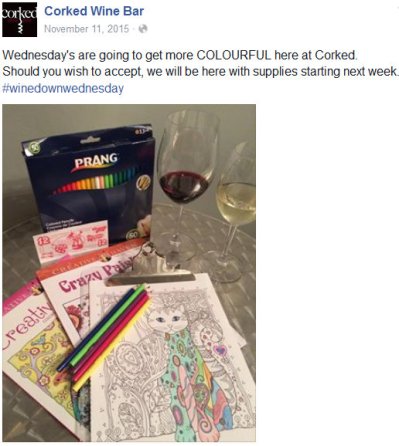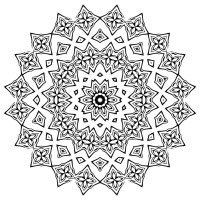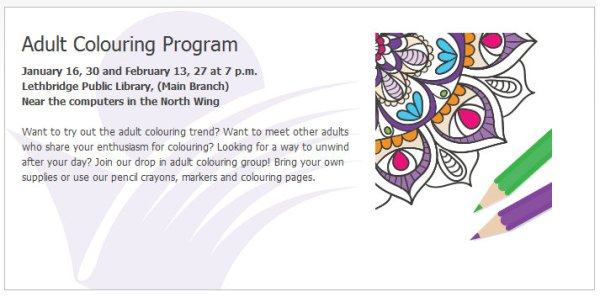As a child, I always loved colouring and, in recent years, as an adult, I have embraced opportunities to colour with my nieces. At restaurants where the tables are covered with brown kraft paper and crayons are placed on the table, I always experience a feeling of joy. I appreciate being given the chance and permission to create and colour in an adult setting.
But in 2015, colouring moved from being an activity that was primarily engaged in by children to one that was important to adults. The growth of the activity was supported with the introduction of wide variety of colouring books and fancy coloured pencil sets. In fact, adult colouring books were among the most popular books in 2015 in United States and Canada. On Amazon.com, three of the top 10 books for the year were adult colouring books and there were five colouring books on the Amazon.ca top 10 books list.
In 2015, Facebook groups were created for adults to share their completed coloring pages or their works in progress. Events and meet ups were hosted for adult colourers. In January 2016, an adult coloring night event (Martin & Ouellet, 2016) for charity in Toronto sold out! Coloring nights have been a low-tech hit at libraries as well with a number of small town and urban libraries offering “color and connect” nights for adults in the community. In my community, even a local wine bar capitalized on the adult colouring trend by hosting adult colouring nights (its first colouring night was held in November 2015).

So what is the appeal of adults returning to an activity that was likely a part of their leisure when they were children? Is it nostalgia? Is it the relatively inexpensive nature of the activity (although some people are willing to pay up to $168 for a box of coloured pencils; Martin & Ouellet, 2016). Is it that it can be done anywhere and at anytime? Is that you can enjoy the activity for 5 minutes and later pick up where you left off with relative ease? Is it that as your time devoted to the activity accumulates, you have a finished product?
Currently, there is very limited academic research on the adult colouring phenomenon and it focuses mainly on colouring as art therapy. However, several popular press articles have been written that offer other explanations for the surge in popularity.
Colouring as a Beneficial Form of Play
There is certainly an argument to be made that colouring has become popular among adults because of “a growing trend where more adults are seeking opportunities for play, largely due to the increased recognition of the health benefits it offers” (Umpathy, 2015). Adult life can is full of obligations some of which can be stressful. Play offers a break from work and other day-to-day commitments. Play also stimulates the brain, supports problem-solving and creativity, and is important to relationships (Brown, 2009).
Colouring as Form of Meditation and Supporting Mindfulness
In one The Atlantic article, Beck (2015), suggests that the trend in adult colouring might best fit with trends related to meditation and mindfulness. Colouring brings our focus to doing one thing (assuming you’re also not trying to watch television or help your child with his/her homework). The patterns associated with certain colouring page designs and the repetition associated with is relaxing and calming for some.
The notion that colouring is a form of meditation has been supported by the research of Curry and Kasser (2011) who found colouring did draw participants into a meditative state and allowed them to experience a reduction in feelings of anxiety – if the piece they were colouring was complex enough. “Coloring a mandala for 20 minutes is more effective at reducing anxiety than free-form coloring for 20 minutes”(Curry & Kasser, 2005, p.83). This finding that colouring a mandala might be the type of design that best represents a meditative practice was further supported in a more recent replication study (van der Vennet & Serice, 2012).

Mandala Design
Colouring as a Microflow Experience
Some adult colourers have found colouring offers them a flow experience (McDonald, 2016). Flow is a mental state in which one is so completely absorbed in an experience that time and space and self no longer disrupt the present moment (Csikszentmihalyi, 1990). While colouring can certainly produce feelings similar to flow – being focused, feeling competent in the task we are engaged in, being in “the zone” where time passes without our awareness, Csikszentmihalyi (1990) argues that true flow requires us to stretch our mind or body to accomplish something. Since it is unlikely that colouring pushes us in this way, Csikszentmihalyi believes that colouring could be a microflow experience (Roston, 2016). Microflow does not involve the same level of arousal that flow does – that peak mental arousal when there is a balance between our high level of skill and a fairly high level of challenge. Rather, colouring may be a small, flow-like experience that offsets the boredom that we would otherwise feel when time passes slowly (Whitbourne, 2015). Because with colouring, our skill level is quite high and the challenge level fairly low, we have the opportunity to experience is as a relaxing activity as opposed to one in which we experience high mental arousal.
Colouring as Social Activity and Opportunity to Connect
With the number of out-of-home colouring events advertised, it is difficult to ignore the opportunity for social interaction that may be offered to colourers. In situations where individuals are colouring at a social or meet-up event, I suspect that there is less chance that someone may experience it as meditation and it may not facilitate the same degree of mindfulness that solitary colouring might. However, certainly the opportunity to colour with others can foster social interaction among individuals who share an interest and help develop a sense of belonging. As I mentioned above, libraries, such as the Lethbridge Public Library in Alberta (below), are incorporating adult colouring into their program offerings. The library offers to supply participants with what they need making it a no-cost activity for those who may not be able to afford colouring books or coloured pencils or for those who want to try the activity without committing to purchasing supplies until they know they like it.
Conclusion
Adult colouring is a phenomenon that has offered adults opportunities to access a variety of benefits associated with leisure. It can be a solitary, meditative activity. It can be a social activity that allows you to engage in an interest with others. It can serve as a break from routine and the stresses of everyday life. It can foster creativity. It can be a way to meaningfully relieve boredom while stimulating your brain. If you have yet to engage in adult colouring activities, it may be worth trying (maybe at a no-cost event) to assess what the activity might offer you!
References
Beck, J. (2015, November 4). The zen of the adult coloring books. The Atlantic. Available at: http://www.theatlantic.com/health/archive/2015/11/sorry-benedict-cumberbatch-your-head-is-fine/414010/
Brown, S. L. (2009). Play: How it shapes the brain, opens the imagination, and invigorates the soul. New York, Avery.
Curry, N. A., & Kasser, T. (2005). Can coloring mandalas reduce anxiety? Art Therapy: Journal of the American Art Therapy Association, 22(2), 81-85.
Martin, L., & Ouellet, V. (2016, January 23). Adult colouring book nights sell out fast in Toronto. CBC News. Available at: http://www.cbc.ca/news/canada/toronto/adult-colouring-book-nights-1.3415958
McDonald, J. (2016). Coloring flow. Available at: http://livelikeyoucan.com/coloring-flow/
Roston, T. (2016). Why grown-ups love coloring books too. Available at: http://ideas.ted.com/why-grown-ups-love-coloring-books-too/
Umapathy, K. (2015). Adult coloring books capitalize on Play Trends.” PSFK blog.
http://www.psfk.com/2015/04/adult-coloring-books-play-trendsjohanna-basford-secret-garden.html
van der Vennet, R., & Serice, S. (2012). Can coloring mandalas reduce anxiety? A replication study. Art Therapy: Journal of the American Art Therapy Association, 29(2), 87-92.
Whitbourne, S. K. (2015). Maximize your happiness by turning on your microflow. Available at: https://www.psychologytoday.com/blog/fulfillment-any-age/201510/maximize-your-happiness-turning-your-microflow


Recent Comments